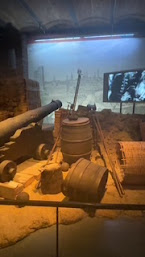Celebrating Corpus Christi and St. John's Eve in Girona
In the last few days in Girona, I visited two very different but equally interesting celebrations: the traditional Corpus Christi festival around the city’s cathedral, and the bonfire-filled chaos of St. John’s Eve, also known as La Nit de Sant Joan. Both were fun and intense, but they gave me a look into how culture, space, and community identity come together in public celebrations. From a class perspective, these moments connected perfectly to POL 150’s discussions of citizenship and nationalism, and POL 399’s exploration of urban space, regulation, and public safety.
The first festival, Corpus Christi, took place at the Girona Cathedral. The area was filled with intricate flower carpets, traditional Catalan music, and even a procession featuring a metal rooster that marched ceremonially to a nearby church. It was colorful and very religious, but open to anyone. I learned that Corpus Christi is a Catholic feast celebrating the body of Christ, and the procession and floral displays are meant to symbolize devotion. What struck me was how welcoming and integrated into urban space it was; people flowed freely in and out of the cathedral and into the streets. I researched land use, and in this instance, public celebration transforms urban space into shared identity. In my observations, there were no barricades, no police presence, just quiet, local power through tradition. Quite the opposite lens when looking at land use politics.
But the St. John’s Eve celebration was a completely different experience. Known in Catalonia as La Nit de Sant Joan, it marks the summer solstice, and from what I witnessed, it’s equal parts festival, fire hazard, and collective catharsis. I went to Vista Alegre Park, where we waited until sunset for a massive bonfire to be lit. Kids and adults ran around with sparklers and even launched fireworks directly above the crowd. At many instances, someone spun a lit firework over their head while others danced. What blew my mind was the lack of official oversight, no fire trucks, no barriers, just dry grass and a mountain of wood. Compared to the strict firework rules in the U.S., this felt wild.
From a POL 150 lens, I saw these festivals as reflections of national identity and democratic culture. These weren’t just parties, they were deeply rooted in Catalan traditions that overlooked Spanish nationalism. In class, we’ve talked about multiculturalism and nationalism, and it was clear that these celebrations express a uniquely Catalan identity that values regional autonomy, cultural expression, and community-driven participation. These festivals are political in the sense that local identity is within a larger national one, without ever needing a speech or protest sign.
But the events also raised questions I've looked at in POL 399, especially about urban land and the use of public space. The lack of visible safety planning at the bonfire, especially with kids launching fireworks and no emergency response in sight, was honestly alarming. It reminded me that in urban planning, different cultures have different tolerances for risk, regulation, and informal public behavior. In the U.S., these events would probably be licensed, fenced off, and filled with firefighters. Here, it was about trust, tradition, and celebration, and I’m still not sure whether that felt freeing or risky, or both. It made me think of Amorim-Maia et al.’s article on “Governing Intersectional Climate Justice in Barcelona”, which explores how city planning often claims to prioritize care and sustainability, but can be uneven and reactive in practice. In this case, the celebration showed how cultural norms sometimes override safety protocols, and how public space becomes a site of both inclusion and risk
These experiences made me reflect on how public celebrations define belonging, and how culture shows up in physical space, not just in policies or buildings, but in all the elements of a festival. In Girona, the land wasn't just used; they were meant for tradition, identity, and celebration (and maybe chaos).





Comments
Post a Comment